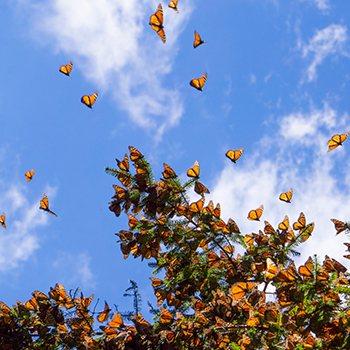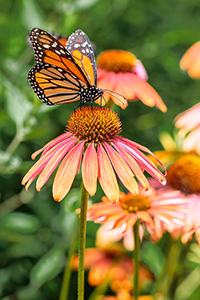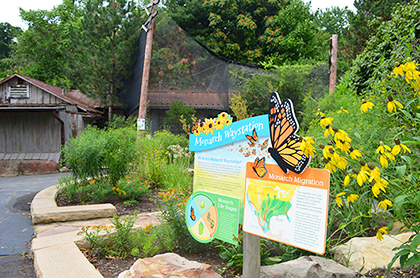 Monarch butterflies are truly the “kings” of the butterfly kingdom. With a wingspan of almost 5 inches, and wings of brilliant orange, red, yellow and black, monarchs are some of the largest and most visually striking butterflies in North America.
Monarch butterflies are truly the “kings” of the butterfly kingdom. With a wingspan of almost 5 inches, and wings of brilliant orange, red, yellow and black, monarchs are some of the largest and most visually striking butterflies in North America.
Unfortunately, their beauty does not make them immune to our changing world, and both the eastern and western populations of this magnificent creature are in decline due to habitat destruction and pesticide use, mainly due to crop production.
Monarch Migration
One of the greatest wonders of the natural world is the monarch butterfly migration, which takes four generations to complete.
The first three generations of monarchs hatch from eggs laid on milkweed plants. The larvae (caterpillars) feed on the milkweed until they are ready to metamorphose and fly north to lay their eggs. Each of these generations lives for only 2-6 weeks.
Fourth generation monarchs, however, are quite different. Instead of dying after a few weeks, these monarchs live for six to eight months. This elongated lifespan allows them to migrate south for the winter and hibernate in warmer climates such as Mexico. When this generation awakes from its hibernation in February or March, they once again fly north and find milkweed plants to lay their eggs, and the cycle starts over.
The Challenge
Since monarchs lay their eggs exclusively on milkweed, it is essential to maintain milkweed populations in North America as stopovers for monarchs flying north in the spring and south in the fall. Unfortunately, wild milkweed populations are dwindling.
 Scientists estimate that in the last 20 years, monarchs have lost more that 165 million acres of habitat, including more than 30% of their summer breeding grounds. This is caused by the removal of prairies and wild fields across the country to make way for farmland, as well as the overuse of pesticides that kills wild milkweed. Without milkweed to make their home, the monarch migration is becoming smaller and smaller each year.
Scientists estimate that in the last 20 years, monarchs have lost more that 165 million acres of habitat, including more than 30% of their summer breeding grounds. This is caused by the removal of prairies and wild fields across the country to make way for farmland, as well as the overuse of pesticides that kills wild milkweed. Without milkweed to make their home, the monarch migration is becoming smaller and smaller each year.
“Think of it as if you were driving cross-country,” says Kris Jackson, Akron Zoo Operations Coordinator and former horticulturist. “How far do you think you could go on one tank of gas, or on one meal without a stop? Sometimes conservation can be as simple as realizing that we share our habitats – our yards – with beautiful, unique species like the monarch.”
Monarch Waystations
Since the decline of the monarch, organizations such as Monarch Watch have encouraged individuals and businesses across North America to install monarch waystations as a way to compensate for the loss of natural monarch habitats. We installed our monarch waystation at the Akron Zoo in 2015 as an example to the community of how simple conservation projects can be.
“The Monarch Watch Certified Monarch Waystation program encourages people to provide the resources necessary for monarchs to migrate successfully from Canada to Mexico every year,” says Jackson. “Monarchs will only lay their eggs on milkweeds (Asclepias species), which is one of the requirements to become a certified waystation.”
Our waystation is filled with several species of milkweed, as well as native Ohio plants that benefit pollinators, such as goldenrod, asters and brown-eyed susan. These pollinator plants make the waystation the perfect rest stop for monarchs as well as other native pollinators.
“We are able to connect our community to wildlife through our gardens here at the zoo in a very direct way,” says Akron Zoo Senior Horticulturist Kelly Licata. “The plants that we use are a direct example of what visitors can plant in their own backyards. When guests take a walk through our waystation and see how alive it is with interesting insects, including monarch butterflies, we hope that they are inspired to use some of these prairie plants in their own gardens which are not only beneficial to pollinators, but to the Ohio landscape.”
 What You Can Do to Help!
What You Can Do to Help!
- Participate in Western Monarch Day Celebrations!
Western Monarch Day, February 5, celebrates the western monarch population and encourages citizens to get involved in the protection of monarch habitats. - Consider Planting a Waystation at your home, school or workplace.
“Way Stations are the perfect citizen science project, because the average homeowner can easily create one,” says Licata. “If you are able to dedicate a small section of yard to pollinator-friendly plants and a water source, you can make a difference to the monarch population. Certifying your site at www.monarchwatch.org helps scientists to track the progress made by this effort.” - Monitor your use of herbicides and pesticides.
Herbicides containing glyphosate kill milkweed plants and leave butterflies with nowhere to stay. Consider less-toxic options, or even weeding by hand!
Encourage natural pest control options, like birds, and tolerate a minimal amount of damage to leaves and plants caused by caterpillars. - Be a citizen advocate for monarchs.
Your local wildflower society, state native plant society, garden club or Master Gardeners may offer opportunities to advocate for monarchs and to create Monarch Waystations in community gardens, parks and along roadsides.
By Erica Rymer, Events and Marketing Specialist. Published Feb. 5, 2019.
